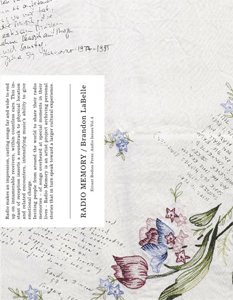Radio makes an impression, casting songs far and wide to end up on innumerable receivers, within countless ears. This instant of reception inserts a soundtrack to physical location and the encounters happening, intensifying music's ability to give emotional charge: a sound in the distance, playing on a stranger's ghetto blaster, or traveling from an open window, across a city street, to arrive at the moment to become forever associated with a certain happening, where song and event are fused, inseparable.
Inviting people from around the world to send in their radio memories — of songs overheard at special moments in their lives — "Radio Memory" is a collection of stories revealing highly personal experiences that in turn speak toward a larger cultural picture. Are such memories partially created by the songs themselves, rather than being strictly supplements to them? In what way does radio play a part in leaving marks on the psyche? And what may a catalogue of radio memories reveal about the musical landscape?
Cataloguing the memories, "Radio Memory" is an artist project by Brandon LaBelle. Initiated in 2005 and continuing today, the book documents the artist's related installations, along with a CD of new work, making a small testament to the power of transmission. Including additional contributions by curator and theorist
Bastien Gallet and Carmen Cebreros Urzaiz.
Brandon LaBelle is a
musician, artist, writer, theorist, curator, educator and editor based in Berlin.
His work, based on performance,
sound installation, recording and use of found sounds, focuses on questions of agency, community, pirate culture, and poetics, which results in a range of collaborative and para-institutional initiatives, including: The Listening Biennial and Academy (2021-), Communities in Movement (2019-), The Living School (2014-16), Oficina de Autonomia (2017),
The Imaginary Republic (2014-19),
Dirty Ear Forum (2013-), Surface Tension (2003-2008), and
Surface Tension (1998-2002). LaBelle reflects fluently on his artistic practice, drawing attention to the social dimensions of listening and manner in which sounds, in multiple variations, play upon public spaces, and drawing connections across media and incorporate video, as well as architectural and sculptural vocabularies into an expanded field that embraces rhetorical and spatial challenges.
In 1995 he founded
Errant Bodies Press, an independent publishing house supporting work in sound art and studies, performance and poetics, artistic research and contemporary political thought.

